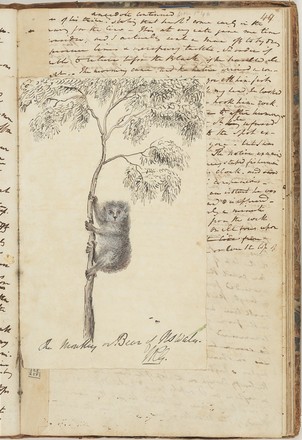Excerpt - Govett's Notes on The Monkey of NS Wales
By Williamt Govett
"Description of the Loris, or slowpaced Lemur of which the accompanying sketch is a correct representation. This animal is common to N.S. Wales, and is generally found in the Stringy bark forests – They are numerous upon the ridges leading to Cox’s River – below the mountain precipices – also in the Ravines wh. open into the Hawkesbury River and its various other parts of the Colony.
They are called by some Monkeys by other ‘Bears’ but they by no means answer to either title. I first took it to be the Sloth of B[indecipherable] but it differs materially from that animal . It mostly resembles the Loris or slow paced Lemur of India. I have shot several and caught one or two of them alive by the assistance of Blacks both young & old wh. I have kept at the tents for some time – and from what I have observed I can give the following description – When full grown they may be almost the size of a male or China pig. they have four hands having [indecipherable] talons. are armed wh. nails exceedingly sharp, nearly an inch long and curved – The fur is of a dark grey colour, very thick , & extremely soft. It is darker on the back & [indecipherable] under the throat & belly and slightly tinged wh. a reddish brown about the rump.
The countenance is by no means disagreeable. Harmless looking & pitiful. The nose is somewhat elongated and tipped as if wh. black leather The ears are almost concealed in the thickness of the face, but have inwardly whitish hairs. The eyes are round and dark, sometimes expressive and the mouth is small and they have no tail.
Like most other animals of the colony they are drowsy & stupid by day, but become more animated at night. Are by no means active however but rather slow in motion and seemed formed for climbing trees and when disturbed they make a melancholy cry exciting pity. They feed upon the tops of trees selecting the blossoms & fresh vegetation."



 Back to list
Back to list